United States
| United States of America | ||||||
|---|---|---|---|---|---|---|
| ||||||
| Motto: In God We Trust (official) E Pluribus Unum (traditional) (Latin: Out of Many, One) | ||||||
| Anthem: "The Star-Spangled Banner" | ||||||
 | ||||||
| Capital | Washington, D.C. 38°53′N 77°01′W / 38.883°N 77.017°W | |||||
| Largest city | New York City | |||||
| Official language(s) | None at federal level[a] | |||||
| National language | English (de facto)[b] | |||||
| Demonym | American | |||||
| Government | Federal presidential constitutional republic | |||||
| - | President | Barack Obama (D) | ||||
| - | Vice President | Joe Biden (D) | ||||
| - | Speaker of the House | John Boehner (R) | ||||
| - | Chief Justice | John Roberts | ||||
| Legislature | Congress | |||||
| - | Upper House | Senate | ||||
| - | Lower House | House of Representatives | ||||
| Independence from the Kingdom of Great Britain | ||||||
| - | Declared | July 4, 1776 | ||||
| - | Recognized | September 3, 1783 | ||||
| - | Current constitution | June 21, 1788 | ||||
| Area | ||||||
| - | Total | 9,826,675 km2 [1][c](3rd/4th) 3,794,101 sq mi | ||||
| - | Water (%) | 6.76 | ||||
| Population | ||||||
| - | 2010 census | 308,745,538[2] | ||||
| - | Density | 33.7/km2 87.4/sq mi | ||||
| GDP (PPP) | 2010 estimate | |||||
| - | Total | $14.658 trillion[3] (1st) | ||||
| - | Per capita | $47,123[3] (6th) | ||||
| GDP (nominal) | 2010 estimate | |||||
| - | Total | $14.658 trillion[3] (1st) | ||||
| - | Per capita | $47,132[3] (9th) | ||||
| Gini (2007) | 45.0[1] (44th) | |||||
| HDI (2010) | ||||||
| Currency | United States dollar ($) (USD) | |||||
| Time zone | (UTC−5 to −10) | |||||
| - | Summer (DST) | (UTC−4 to −10) | ||||
| Date formats | m/d/yy (AD) | |||||
| Drives on the | right | |||||
| Internet TLD | .us .gov .mil .edu | |||||
| Calling code | +1 | |||||
| ^ a. English is the official language of at least 28 states—some sources give a higher figure, based on differing definitions of "official".[5] English and Hawaiian are both official languages in the state of Hawaii. ^ b. English is the de facto language of American government and the sole language spoken at home by 80% of Americans age five and older. Spanish is the second most commonly spoken language. ^ c. Whether the United States or the People's Republic of China is larger is disputed. The figure given is from the U.S. Central Intelligence Agency's World Factbook. Other sources give smaller figures. All authoritative calculations of the country's size include only the 50 states and the District of Columbia, not the territories. ^ d. The population estimate includes people whose usual residence is in the fifty states and the District of Columbia, including noncitizens. It does not include either those living in the territories, amounting to more than 4 million U.S. citizens (most in Puerto Rico), or U.S. citizens living outside the United States. | ||||||
The United States of America (also referred to as the United States, the U.S., the USA, or America) is a federal constitutional republic comprising fifty states and a federal district. The country is situated mostly in central North America, where its forty-eight contiguous states and Washington, D.C., the capital district, lie between the Pacific and Atlantic Oceans, bordered by Canada to the north and Mexico to the south. The state of Alaska is in the northwest of the continent, with Canada to the east and Russia to the west across the Bering Strait. The state of Hawaii is an archipelago in the mid-Pacific. The country also possesses several territories in the Caribbean and Pacific.
At 3.79 million square miles (9.83 million km2) and with over 310 million people, the United States is the third or fourth largest country by total area, and the third largest both by land area and population. It is one of the world's most ethnically diverse and multicultural nations, the product of large-scale immigration from many countries.[6] The U.S. economy is the world's largest national economy, with an estimated 2010 GDP of $14.799 trillion (23% of nominal global GDP and 20% of global GDP at purchasing power parity).[3][7]
Indigenous peoples of Asian origin have inhabited what is now the mainland United States for many thousands of years. This Native American population was greatly reduced by disease and warfare after European contact. The United States was founded by thirteen British colonies located along the Atlantic seaboard. On July 4, 1776, they issued the Declaration of Independence, which proclaimed their right to self-determination and their establishment of a cooperative union. The rebellious states defeated the British Empire in the American Revolution, the first successful colonial war of independence.[8] The current United States Constitution was adopted on September 17, 1787; its ratification the following year made the states part of a single republic with a strong federal government. The Bill of Rights, comprising ten constitutional amendments guaranteeing many fundamental civil rights and freedoms, was ratified in 1791.
Through the 19th century, the United States displaced native tribes, acquired land from France, Spain, the United Kingdom, Mexico, and Russia, and annexed the Republic of Texas and the Republic of Hawaii. Disputes between the agrarian South and industrial North over the expansion of the institution of slavery and states' rights provoked the American Civil War of the 1860s. The North's victory prevented a permanent split of the country and led to the end of legal slavery in the United States. By the 1870s, the national economy was the world's largest.[9] The Spanish–American War and World War I confirmed the country's status as a military power. It emerged from World War II as the first country with nuclear weapons and a permanent member of the United Nations Security Council. The end of the Cold War and the dissolution of the Soviet Union left the United States as the sole superpower. The country accounts for 43% of global military spending and is a leading economic, political, and cultural force in the world.[10]
Contents[hide]
|
Etymology
In 1507, German cartographer Martin Waldseemüller produced a world map on which he named the lands of the Western Hemisphere "America" after Italian explorer and cartographer Amerigo Vespucci.[11] The former British colonies first used the country's modern name in the Declaration of Independence, the "unanimous Declaration of the thirteen united States of America" adopted by the "Representatives of the united States of America" on July 4, 1776.[12] On November 15, 1777, the Second Continental Congress adopted the Articles of Confederation, which states, "The Stile of this Confederacy shall be 'The United States of America.'" The Franco-American treaties of 1778 used "United States of North America", but from July 11, 1778, "United States of America" was used on the country's bills of exchange, and it has been the official name ever since.[13]
The short form "United States" is also standard. Other common forms include the "U.S.", the "USA", and "America". Colloquial names include the "U.S. of A." and, internationally, the "States". "Columbia", a once popular name for the United States, derives from Christopher Columbus; it appears in the name "District of Columbia".
The standard way to refer to a citizen of the United States is as an "American". Though "United States" is the official appositional term, "American" and "U.S." are more commonly used to refer to the country adjectivally ("American values," "U.S. forces"). "American" is rarely used in English to refer to people not connected to the United States.[14]
The phrase "United States" was originally treated as plural—e.g., "the United States are"—including in the Thirteenth Amendment to the United States Constitution, ratified in 1865. It became common to treat it as singular—e.g., "the United States is"—after the end of the Civil War. The singular form is now standard; the plural form is retained in the idiom "these United States".[15]
Geography, climate, and environment
The land area of the contiguous United States is approximately 1.9 billion acres (770 million hectares). Alaska, separated from the contiguous United States by Canada, is the largest state at 365 million acres (150 million hectares). Hawaii, occupying an archipelago in the central Pacific, southwest of North America, has just over 4 million acres (1.6 million hectares).[16] The United States is the world's third or fourth largest nation by total area (land and water), ranking behind Russia and Canada and just above or below China. The ranking varies depending on how two territories disputed by China and India are counted and how the total size of the United States is calculated: the CIA World Factbook gives 3,794,101 square miles (9,826,675 km2),[1] the United Nations Statistics Division gives 3,717,813 square miles (9,629,091 km2),[17] and the Encyclopædia Britannica gives 3,676,486 square miles (9,522,055 km2).[18] Including only land area, the United States is third in size behind Russia and China, just ahead of Canada.[19]
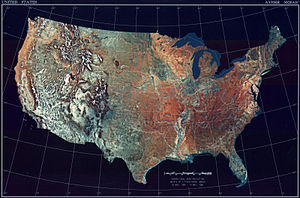
The coastal plain of the Atlantic seaboard gives way further inland to deciduous forests and the rolling hills of the Piedmont. The Appalachian Mountains divide the eastern seaboard from the Great Lakes and the grasslands of the Midwest. The Mississippi–Missouri River, the world's fourth longest river system, runs mainly north–south through the heart of the country. The flat, fertile prairie of the Great Plains stretches to the west, interrupted by a highland region in the southeast. The Rocky Mountains, at the western edge of the Great Plains, extend north to south across the country, reaching altitudes higher than 14,000 feet (4,300 m) in Colorado. Farther west are the rocky Great Basin and deserts such as the Mojave. The Sierra Nevada and Cascade mountain ranges run close to the Pacific coast. At 20,320 feet (6,194 m), Alaska's Mount McKinley is the tallest peak in the country and in North America. Active volcanoes are common throughout Alaska's Alexander and Aleutian Islands, and Hawaii consists of volcanic islands. The supervolcano underlying Yellowstone National Park in the Rockies is the continent's largest volcanic feature.[20]

The United States, with its large size and geographic variety, includes most climate types. To the east of the 100th meridian, the climate ranges from humid continental in the north to humid subtropical in the south. The southern tip of Florida is tropical, as is Hawaii. The Great Plains west of the 100th meridian are semi-arid. Much of the Western mountains are alpine. The climate is arid in the Great Basin, desert in the Southwest, Mediterranean in coastal California, and oceanic in coastal Oregon and Washington and southern Alaska. Most of Alaska is subarctic or polar. Extreme weather is not uncommon—the states bordering the Gulf of Mexico are prone to hurricanes, and most of the world's tornadoes occur within the country, mainly in the Midwest's Tornado Alley.[21]
The U.S. ecology is considered "megadiverse": about 17,000 species of vascular plants occur in the contiguous United States and Alaska, and over 1,800 species of flowering plants are found in Hawaii, few of which occur on the mainland.[22] The United States is home to more than 400 mammal, 750 bird, and 500 reptile and amphibian species.[23] About 91,000 insect species have been described.[24] The Endangered Species Act of 1973 protects threatened and endangered species and their habitats, which are monitored by the United States Fish and Wildlife Service. There are fifty-eight national parks and hundreds of other federally managed parks, forests, and wilderness areas.[25] Altogether, the government owns 28.8% of the country's land area.[26] Most of this is protected, though some is leased for oil and gas drilling, mining, logging, or cattle ranching; 2.4% is used for military purposes.[26]
History
Native Americans and European settlers
The indigenous peoples of the U.S. mainland, including Alaska Natives, are believed to have migrated from Asia, beginning between 12,000 and 40,000 years ago.[27] Some, such as the pre-Columbian Mississippian culture, developed advanced agriculture, grand architecture, and state-level societies. After Europeans began settling the Americas, many millions of indigenous Americans died from epidemics of imported diseases such as smallpox.[28]

In 1492, Genoese explorer Christopher Columbus, under contract to the Spanish crown, reached several Caribbean islands, making first contact with the indigenous people. On April 2, 1513, Spanish conquistador Juan Ponce de León landed on what he called "La Florida"—the first documented European arrival on what would become the U.S. mainland. Spanish settlements in the region were followed by ones in the present-day southwestern United States that drew thousands through Mexico. French fur traders established outposts of New France around the Great Lakes; France eventually claimed much of the North American interior, down to the Gulf of Mexico. The first successful English settlements were the Virginia Colony in Jamestown in 1607 and the Pilgrims' Plymouth Colony in 1620. The 1628 chartering of the Massachusetts Bay Colony resulted in a wave of migration; by 1634, New England had been settled by some 10,000 Puritans. Between the late 1610s and the American Revolution, about 50,000 convicts were shipped to Britain's American colonies.[29] Beginning in 1614, the Dutch settled along the lower Hudson River, including New Amsterdam on Manhattan Island.
In 1674, the Dutch ceded their American territory to England; the province of New Netherland was renamed New York. Many new immigrants, especially to the South, were indentured servants—some two-thirds of all Virginia immigrants between 1630 and 1680.[30] By the turn of the 18th century, African slaves were becoming the primary source of bonded labor. With the 1729 division of the Carolinas and the 1732 colonization of Georgia, the thirteen British colonies that would become the United States of America were established. All had local governments with elections open to most free men, with a growing devotion to the ancient rights of Englishmen and a sense of self-government stimulating support for republicanism. All legalized the African slave trade. With high birth rates, low death rates, and steady immigration, the colonial population grew rapidly. The Christian revivalist movement of the 1730s and 1740s known as the Great Awakening fueled interest in both religion and religious liberty. In the French and Indian War, British forces seized Canada from the French, but the francophone population remained politically isolated from the southern colonies. Excluding the Native Americans (popularly known as "American Indians"), who were being displaced, those thirteen colonies had a population of 2.6 million in 1770, about one-third that of Britain; nearly one in five Americans were black slaves.[31] Though subject to British taxation, the American colonials had no representation in the Parliament of Great Britain.
Independence and expansion

Tensions between American colonials and the British during the revolutionary period of the 1760s and early 1770s led to the American Revolutionary War, fought from 1775 through 1781. On June 14, 1775, the Continental Congress, convening in Philadelphia, established a Continental Army under the command of George Washington. Proclaiming that "all men are created equal" and endowed with "certain unalienable Rights," the Congress adopted the Declaration of Independence, drafted largely by Thomas Jefferson, on July 4, 1776. That date is now celebrated annually as America's Independence Day. In 1777, the Articles of Confederation established a weak confederal government that operated until 1789.
After the British defeat by American forces assisted by the French and the Spaniards, Great Britain recognized the independence of the United States and the states' sovereignty over American territory west to the Mississippi River. A constitutional convention was organized in 1787 by those wishing to establish a strong national government, with powers of taxation. The United States Constitution was ratified in 1788, and the new republic's first Senate, House of Representatives, and president—George Washington—took office in 1789. The Bill of Rights, forbidding federal restriction of personal freedoms and guaranteeing a range of legal protections, was adopted in 1791.
Attitudes toward slavery were shifting; a clause in the Constitution protected the African slave trade only until 1808. The Northern states abolished slavery between 1780 and 1804, leaving the slave states of the South as defenders of the "peculiar institution." The Second Great Awakening, beginning about 1800, made evangelicalism a force behind various social reform movements, including abolitionism.
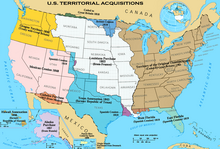
Americans' eagerness to expand westward prompted a long series of Indian Wars. The Louisiana Purchase of French-claimed territory under President Thomas Jefferson in 1803 almost doubled the nation's size.[32] The War of 1812, declared against Britain over various grievances and fought to a draw, strengthened U.S. nationalism. A series of U.S. military incursions into Florida led Spain to cede it and other Gulf Coast territory in 1819. The Trail of Tears in the 1830s exemplified the Indian removal policy that stripped the native peoples of their land. The United States annexed the Republic of Texas in 1845. The concept of Manifest Destiny was popularized during this time.[33] The 1846 Oregon Treaty with Britain led to U.S. control of the present-day American Northwest. The U.S. victory in the Mexican-American War resulted in the 1848 cession of California and much of the present-day American Southwest. The California Gold Rush of 1848–49 further spurred western migration. New railways made relocation easier for settlers and increased conflicts with Native Americans. Over a half-century, up to 40 million American bison, or buffalo, were slaughtered for skins and meat and to ease the railways' spread. The loss of the buffalo, a primary resource for the plains Indians, was an existential blow to many native cultures.
Civil War and industrialization

Tensions between slave and free states mounted with arguments over the relationship between the state and federal governments, as well as violent conflicts over the spread of slavery into new states. Abraham Lincoln, candidate of the largely antislavery Republican Party, was elected president in 1860. Before he took office, seven slave states declared their secession—which the federal government maintained was illegal—and formed the Confederate States of America. With the Confederate attack upon Fort Sumter, the American Civil War began and four more slave states joined the Confederacy. Lincoln's Emancipation Proclamation in 1863 declared slaves in the Confederacy to be free. Following the Union victory in 1865, three amendments to the U.S. Constitution ensured freedom for the nearly four million African Americans who had been slaves,[34] made them citizens, and gave them voting rights. The war and its resolution led to a substantial increase in federal power.[35] The war remains the deadliest conflict in American history, resulting in the deaths of 620,000 soldiers.[36]
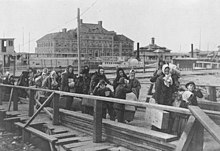
After the war, the assassination of Lincoln radicalized Republican Reconstruction policies aimed at reintegrating and rebuilding the Southern states while ensuring the rights of the newly freed slaves. The resolution of the disputed 1876 presidential election by the Compromise of 1877 ended Reconstruction; Jim Crow laws soon disenfranchised many African Americans. In the North, urbanization and an unprecedented influx of immigrants from Southern and Eastern Europe hastened the country's industrialization. The wave of immigration, lasting until 1929, provided labor and transformed American culture. National infrastructure development spurred economic growth. The 1867 Alaska Purchase from Russia completed the country's mainland expansion. The Wounded Knee Massacre in 1890 was the last major armed conflict of the Indian Wars. In 1893, the indigenous monarchy of the Pacific Kingdom of Hawaii was overthrown in a coup led by American residents; the United States annexed the archipelago in 1898. Victory in the Spanish–American War the same year demonstrated that the United States was a world power and led to the annexation of Puerto Rico, Guam, and the Philippines.[37] The Philippines gained independence a half-century later; Puerto Rico and Guam remain U.S. territories.
World War I, Great Depression, and World War II
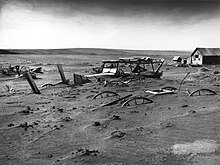
At the outbreak of World War I in 1914, the United States remained neutral. Most Americans sympathized with the British and French, although many opposed intervention.[38] In 1917, the United States joined the Allies, helping to turn the tide against the Central Powers. After the war, the Senate did not ratify the Treaty of Versailles, which established the League of Nations. The country pursued a policy of unilateralism, verging on isolationism.[39] In 1920, the women's rights movement won passage of a constitutional amendment granting women's suffrage. The prosperity of the Roaring Twenties ended with the Wall Street Crash of 1929 that triggered the Great Depression. After his election as president in 1932, Franklin D. Roosevelt responded with the New Deal, a range of policies increasing government intervention in the economy. The Dust Bowl of the mid-1930s impoverished many farming communities and spurred a new wave of western migration.
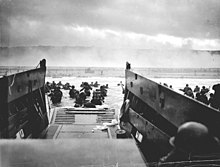
The United States, effectively neutral during World War II's early stages after Nazi Germany's invasion of Poland in September 1939, began supplying materiel to the Allies in March 1941 through the Lend-Lease program. On December 7, 1941, the Empire of Japan launched a surprise attack on Pearl Harbor, prompting the United States to join the Allies against the Axis powers as well as the internment of Japanese Americans by the thousands.[40] Participation in the war spurred capital investment and industrial capacity. Among the major combatants, the United States was the only nation to become richer—indeed, far richer—instead of poorer because of the war.[41] Allied conferences at Bretton Woods and Yalta outlined a new system of international organizations that placed the United States and Soviet Union at the center of world affairs. As victory was won in Europe, a 1945 international conference held in San Francisco produced the United Nations Charter, which became active after the war.[42] The United States, having developed the first nuclear weapons, used them on the Japanese cities of Hiroshima and Nagasaki in August. Japan surrendered on September 2, ending the war.[43]
Cold War and protest politics
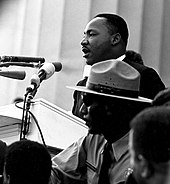
The United States and Soviet Union jockeyed for power after World War II during the Cold War, dominating the military affairs of Europe through NATO and the Warsaw Pact, and engaging in proxy wars in many locations. Resisting leftist land and income redistribution projects around the world, the United States often supported authoritarian governments. American troops fought Communist Chinese forces in the Korean War of 1950–53. The House Un-American Activities Committee pursued a series of investigations into suspected leftist subversion, while Senator Joseph McCarthy became the figurehead of anticommunist sentiment.
The 1961 Soviet launch of the first manned spaceflight prompted President John F. Kennedy's call for the United States to be first to land "a man on the moon", achieved in 1969. Kennedy also faced a tense nuclear showdown with Soviet forces in Cuba. Meanwhile, the United States experienced sustained economic expansion. A growing civil rights movement, symbolized and led by African Americans such as Rosa Parks, Martin Luther King, Jr., and James Bevel, used nonviolence to confront segregation and discrimination. Following Kennedy's assassination in 1963, the Civil Rights Act of 1964 and Voting Rights Act of 1965 were passed under President Lyndon B. Johnson. Johnson and his successor, Richard Nixon, expanded a proxy war in Southeast Asia into the unsuccessful Vietnam War. A widespread countercultural movement grew, fueled by opposition to the war, black nationalism, and the sexual revolution. Betty Friedan, Gloria Steinem, and others led a new wave of feminism that sought political, social, and economic equality for women.
As a result of the Watergate scandal, in 1974 Nixon became the first U.S. president to resign, to avoid being impeached on charges including obstruction of justice and abuse of power; he was succeeded by Vice President Gerald Ford. The Jimmy Carter administration of the late 1970s was marked by stagflation and the Iran hostage crisis. The election of Ronald Reagan as president in 1980 heralded a rightward shift in American politics, reflected in major changes in taxation and spending priorities. His second term in office brought both the Iran-Contra scandal and significant diplomatic progress with the Soviet Union. The subsequent Soviet collapse ended the Cold War.
Contemporary era
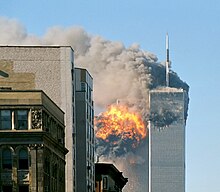
Under President George H. W. Bush, the United States took a lead role in the UN–sanctioned Gulf War. The longest economic expansion in modern U.S. history—from March 1991 to March 2001—encompassed the Bill Clinton administration and the dot-com bubble.[44] A civil lawsuit and sex scandal led to Clinton's impeachment in 1998, but he remained in office. The 2000 presidential election, one of the closest in American history, was resolved by a U.S. Supreme Court decision—George W. Bush, son of George H. W. Bush, became president.
On September 11, 2001, al-Qaeda terrorists struck the World Trade Center in New York City and The Pentagon near Washington, D.C., killing nearly three thousand people. In response, the Bush administration launched the global War on Terror. In October 2001, U.S. forces led an invasion of Afghanistan, removing the Taliban government and al-Qaeda training camps. Taliban insurgents continue to fight a guerrilla war. In 2002, the Bush administration began to press for regime change in Iraq on controversial grounds.[45] Lacking the support of NATO or an explicit UN mandate for military intervention, Bush organized a Coalition of the Willing; coalition forces preemptively invaded Iraq in 2003, removing dictator Saddam Hussein. In 2005, Hurricane Katrina caused severe destruction along much of the Gulf Coast, devastating New Orleans. On November 4, 2008, amid a global economic recession the first African American president, Barack Obama, was elected. In 2010, major health care and financial system reforms were enacted. The Deepwater Horizon oil spill in the Gulf of Mexico that year became the largest peacetime oil disaster in history.[46]
Government and elections

The United States is the world's oldest surviving federation. It is a constitutional republic and representative democracy, "in which majority rule is tempered by minority rights protected by law."[47] The government is regulated by a system of checks and balances defined by the U.S. Constitution, which serves as the country's supreme legal document. In the American federalist system, citizens are usually subject to three levels of government, federal, state, and local; the local government's duties are commonly split between county and municipal governments. In almost all cases, executive and legislative officials are elected by a plurality vote of citizens by district. There is no proportional representation at the federal level, and it is very rare at lower levels.
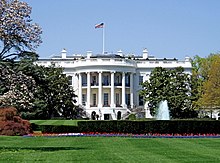
The federal government is composed of three branches:
- Legislative: The bicameral Congress, made up of the Senate and the House of Representatives, makes federal law, declares war, approves treaties, has the power of the purse, and has the power of impeachment, by which it can remove sitting members of the government.
- Executive: The president is the commander-in-chief of the military, can veto legislative bills before they become law, and appoints the members of the Cabinet (subject to Senate approval) and other officers, who administer and enforce federal laws and policies.
- Judicial: The Supreme Court and lower federal courts, whose judges are appointed by the president with Senate approval, interpret laws and overturn those they find unconstitutional.
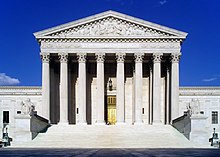
The House of Representatives has 435 voting members, each representing a congressional district for a two-year term. House seats are apportioned among the states by population every tenth year. As of the 2000 census, seven states have the minimum of one representative, while California, the most populous state, has fifty-three. The Senate has 100 members with each state having two senators, elected at-large to six-year terms; one third of Senate seats are up for election every other year. The president serves a four-year term and may be elected to the office no more than twice. The president is not elected by direct vote, but by an indirect electoral college system in which the determining votes are apportioned by state. The Supreme Court, led by the Chief Justice of the United States, has nine members, who serve for life.
The state governments are structured in roughly similar fashion; Nebraska uniquely has a unicameral legislature. The governor (chief executive) of each state is directly elected. Some state judges and cabinet officers are appointed by the governors of the respective states, while others are elected by popular vote.
All laws and governmental procedures are subject to judicial review, and any law ruled in violation of the Constitution is voided. The original text of the Constitution establishes the structure and responsibilities of the federal government and its relationship with the individual states. Article One protects the right to the "great writ" of habeas corpus, and Article Three guarantees the right to a jury trial in all criminal cases. Amendments to the Constitution require the approval of three-fourths of the states. The Constitution has been amended twenty-seven times; the first ten amendments, which make up the Bill of Rights, and the Fourteenth Amendment form the central basis of Americans' individual rights.
Parties, ideology, and politics

The United States has operated under a two-party system for most of its history. For elective offices at most levels, state-administered primary elections choose the major party nominees for subsequent general elections. Since the general election of 1856, the major parties have been the Democratic Party, founded in 1824, and the Republican Party, founded in 1854. Since the Civil War, only one third-party presidential candidate—former president Theodore Roosevelt, running as a Progressive in 1912—has won as much as 20% of the popular vote.
Within American political culture, the Republican Party is considered center-right or "conservative" and the Democratic Party is considered center-left or "liberal". The states of the Northeast and West Coast and some of the Great Lakes states, known as "blue states", are relatively liberal. The "red states" of the South and parts of the Great Plains and Rocky Mountains are relatively conservative.
The winner of the 2008 presidential election, Democrat Barack Obama, is the 44th U.S. president. All previous presidents were men of solely European descent. The 2010 midterm elections saw the Republican Party take control of the House and make gains in the Senate, where the Democrats retain the majority. In the 112th United States Congress, the Senate comprises 51 Democrats, two independents who caucus with the Democrats, and 47 Republicans; the House comprises 242 Republicans and 193 Democrats. There are 29 Republican and 20 Democratic state governors, as well as one independent.
Political divisions
The United States is a federal union of fifty states. The original thirteen states were the successors of the thirteen colonies that rebelled against British rule. Early in the country's history, three new states were organized on territory separated from the claims of the existing states: Kentucky from Virginia; Tennessee from North Carolina; and Maine from Massachusetts. Most of the other states have been carved from territories obtained through war or purchase by the U.S. government. One set of exceptions comprises Vermont, Texas, and Hawaii: each was an independent republic before joining the union. During the American Civil War, West Virginia broke away from Virginia. The most recent state—Hawaii—achieved statehood on August 21, 1959. The states do not have the right to secede from the union.
The states compose the vast bulk of the U.S. land mass; the two other areas considered integral parts of the country are the District of Columbia, the federal district where the capital, Washington, is located; and Palmyra Atoll, an uninhabited but incorporated territory in the Pacific Ocean. The United States also possesses five major overseas territories: Puerto Rico and the United States Virgin Islands in the Caribbean; and American Samoa, Guam, and the Northern Mariana Islands in the Pacific.[48] Those born in the major territories (except for American Samoa) possess U.S. citizenship.[49] American citizens residing in the territories have many of the same rights and responsibilities as citizens residing in the states; however, they are generally exempt from federal income tax, may not vote for president, and have only nonvoting representation in the U.S. Congress.[50]


Foreign relations and military

The United States exercises global economic, political, and military influence. It is a permanent member of the United Nations Security Council and New York City hosts the United Nations Headquarters. It is a member of the G8, G20, and Organisation for Economic Co-operation and Development. Almost all countries have embassies in Washington, D.C., and many have consulates around the country. Likewise, nearly all nations host American diplomatic missions. However, Cuba, Iran, North Korea, Bhutan, Libya, and the Republic of China (Taiwan) do not have formal diplomatic relations with the United States.
The United States has a "special relationship" with the United Kingdom[51] and strong ties with Canada, Australia, New Zealand, Japan, South Korea, and Israel. It works closely with fellow NATO members on military and security issues and with its neighbors through the Organization of American States and free trade agreements such as the trilateral North American Free Trade Agreement with Canada and Mexico. In 2008, the United States spent a net $25.4 billion on official development assistance, the most in the world. As a share of gross national income (GNI), however, the U.S. contribution of 0.18% ranked last among twenty-two donor states. In contrast, private overseas giving by Americans is relatively generous.[52]

The president holds the title of commander-in-chief of the nation's armed forces and appoints its leaders, the secretary of defense and the Joint Chiefs of Staff. The United States Department of Defense administers the armed forces, including the Army, Navy, Marine Corps, and Air Force. The Coast Guard is run by the Department of Homeland Security in peacetime and the Department of the Navy in time of war. In 2008, the armed forces had 1.4 million personnel on active duty. The Reserves and National Guard brought the total number of troops to 2.3 million. The Department of Defense also employed about 700,000 civilians, not including contractors.[53]
Military service is voluntary, though conscription may occur in wartime through the Selective Service System. American forces can be rapidly deployed by the Air Force's large fleet of transport aircraft, the Navy's eleven active aircraft carriers, and Marine Expeditionary Units at sea with the Navy's Atlantic and Pacific fleets. The military operates 865 bases and facilities abroad,[54] and maintains deployments greater than 100 active duty personnel in 25 foreign countries.[55] The extent of this global military presence has prompted some scholars to describe the United States as maintaining an "empire of bases."[56]
Total U.S. military spending in 2008, more than $600 billion, was over 41% of global military spending and greater than the next fourteen largest national military expenditures combined. The per capita spending of $1,967 was about nine times the world average; at 4% of GDP, the rate was the second-highest among the top fifteen military spenders, after Saudi Arabia.[57] The proposed base Department of Defense budget for 2011, $549 billion, is a 3.4% increase over 2010 and 85% higher than in 2001; an additional $159 billion is proposed for the military campaigns in Iraq and Afghanistan.[58] As of September 2010, the United States is scheduled to have 96,000 troops deployed to Afghanistan, and 50,000 to Iraq.[59] As of January 5, 2011, the United States had suffered 4,432 military fatalities during the Iraq War,[60] and 1,448 during the War in Afghanistan.[61]
Economy
| Economic indicators | ||
|---|---|---|
| Unemployment | 9.1% (May 2011) | [62] |
| GDP growth | 1.8% (1Q 2011), 2.9% (2009 – 2010) | [63] |
| CPI inflation | 3.2% (April 2010 – April 2011) | [64] |
| Poverty | 14.3% (2009) | [65] |
| Public debt | $14.34 trillion (June 9, 2011) | [66] |
| Household net worth | $54.2 trillion (4Q 2009) | [67] |
The United States has a capitalist mixed economy, which is fueled by abundant natural resources, a well-developed infrastructure, and high productivity.[68] According to the International Monetary Fund, the U.S. GDP of $14.799 trillion constitutes 24% of the gross world product at market exchange rates and almost 21% of the gross world product at purchasing power parity (PPP).[3] It has the largest national GDP in the world, though it is about 5% less than the GDP of the European Union at PPP in 2008. The country ranks ninth in the world in nominal GDP per capita and sixth in GDP per capita at PPP.[3]
The United States is the largest importer of goods and third largest exporter, though exports per capita are relatively low. In 2008, the total U.S. trade deficit was $696 billion.[69] Canada, China, Mexico, Japan, and Germany are its top trading partners.[70] In 2007, vehicles constituted both the leading import and leading export commodity.[71] Japan is the largest foreign holder of U.S. public debt, having surpassed China in early 2010.[72] The United States ranks second in the Global Competitiveness Report.[73]

In 2009, the private sector was estimated to constitute 55.3% of the economy, with federal government activity accounting for 24.1% and state and local government activity (including federal transfers) the remaining 20.6%.[74] The economy is postindustrial, with the service sector contributing 67.8% of GDP, though the United States remains an industrial power.[75] The leading business field by gross business receipts is wholesale and retail trade; by net income it is manufacturing.[76] Chemical products are the leading manufacturing field.[77] The United States is the third largest producer of oil in the world, as well as its largest importer.[78] It is the world's number one producer of electrical and nuclear energy, as well as liquid natural gas, sulfur, phosphates, and salt. While agriculture accounts for just under 1% of GDP,[75] the United States is the world's top producer of corn[79] and soybeans.[80] The New York Stock Exchange is the world's largest by dollar volume.[81] Coca-Cola and McDonald's are the two most recognized brands in the world.[82]
In August 2010, the American labor force comprised 154.1 million people. With 21.2 million people, government is the leading field of employment. The largest private employment sector is health care and social assistance, with 16.4 million people.[62] About 12% of workers are unionized, compared to 30% in Western Europe.[83] The World Bank ranks the United States first in the ease of hiring and firing workers.[84] In 2009, the United States had the third highest labor productivity per person in the world, behind Luxembourg and Norway. It was fourth in productivity per hour, behind those two countries and the Netherlands.[85] Compared to Europe, U.S. property and corporate income tax rates are generally higher, while labor and, particularly, consumption tax rates are lower.[86]
Income and human development

According to the United States Census Bureau, the pretax median household income in 2007 was $49,777. The median ranged from $65,469 among Asian American households to $32,584 among African American households.[65] Using purchasing power parity exchange rates, the overall median is similar to the most affluent cluster of developed nations. After declining sharply during the middle of the 20th century, poverty rates have plateaued since the early 1970s, with 11–15% of Americans below the poverty line every year, and 58.5% spending at least one year in poverty between the ages of 25 and 75.[87][88] In 2009, 43.6 million Americans lived in poverty.[65]
The U.S. welfare state is one of the least extensive in the developed world, reducing both relative poverty and absolute poverty by considerably less than the mean for rich nations,[89][90] though combined private and public social expenditures per capita are higher than in any of the Nordic countries.[91] While the American welfare state does well in reducing poverty among the elderly,[92] the young receive relatively little assistance.[93] A 2007 UNICEF study of children's well-being in twenty-one industrialized nations ranked the United States next to last.[94]
Despite strong increases in productivity, low unemployment, and low inflation, income gains since 1980 have been slower than in previous decades, less widely shared, and accompanied by increased economic insecurity. Between 1947 and 1979, real median income rose by over 80% for all classes, with the incomes of poor Americans rising faster than those of the rich.[95][96] Median household income has increased for all classes since 1980,[97] largely owing to more dual-earner households, the closing of the gender gap, and longer work hours, but growth has been slower and strongly tilted toward the very top (see graph).[89][95][98] Consequently, the share of income of the top 1%—21.8% of total reported income in 2005—has more than doubled since 1980,[99] leaving the United States with the greatest income inequality among developed nations.[89][100] The top 1% pays 27.6% of all federal taxes; the top 10% pays 54.7%.[101] Wealth, like income, is highly concentrated: The richest 10% of the adult population possesses 69.8% of the country's household wealth, the second-highest share among developed nations.[102] The top 1% possesses 33.4% of net wealth.[103]
Science and technology

The United States has been a leader in scientific research and technological innovation since the late 19th century. In 1876, Alexander Graham Bell was awarded the first U.S. patent for the telephone. Thomas Edison's laboratory developed the phonograph, the first long-lasting light bulb, and the first viable movie camera. Nikola Tesla pioneered alternating current, the AC motor, and radio. In the early 20th century, the automobile companies of Ransom E. Olds and Henry Ford promoted the assembly line. The Wright brothers, in 1903, made the first sustained and controlled heavier-than-air powered flight.[104]
The rise of Nazism in the 1930s led many European scientists, including Albert Einstein and Enrico Fermi, to immigrate to the United States. During World War II, the Manhattan Project developed nuclear weapons, ushering in the Atomic Age. The Space Race produced rapid advances in rocketry, materials science, and computers. The United States largely developed the ARPANET and its successor, the Internet. Today, the bulk of research and development funding, 64%, comes from the private sector.[105] The United States leads the world in scientific research papers and impact factor.[106] Americans possess high levels of technological consumer goods,[107] and almost half of U.S. households have broadband Internet access.[108] The country is the primary developer and grower of genetically modified food, representing half of the world's biotech crops.[109]


Transportation
Everyday personal transportation in the United States is dominated by the automobile driving on one of 13 million roads.[112] As of 2003, there were 759 automobiles per 1,000 Americans, compared to 472 per 1,000 inhabitants of the European Union the following year.[113] About 40% of personal vehicles are vans, SUVs, or light trucks.[114] The average American adult (accounting for all drivers and nondrivers) spends 55 minutes driving every day, traveling 29 miles (47 km).[115]
The civil airline industry is entirely privately owned, while most major airports are publicly owned. The four largest airlines in the world by passengers carried are American; Southwest Airlines is number one.[116] Of the world's thirty busiest passenger airports, sixteen are in the United States, including the busiest, Hartsfield-Jackson Atlanta International Airport.[117] While transport of goods by rail is extensive, relatively few people use rail to travel, within or between cities.[118] Mass transit accounts for 9% of total U.S. work trips, compared to 38.8% in Europe.[119] Bicycle usage is minimal, well below European levels.[120]
Energy
The United States energy market is 29,000 terawatt hours per year. Energy consumption per capita is 7.8 tons of oil equivalent per year, compared to Germany's 4.2 tons and Canada's 8.3 tons. In 2005, 40% of this energy came from petroleum, 23% from coal, and 22% from natural gas. The remainder was supplied by nuclear power and renewable energy sources.[121] The United States is the world's largest consumer of petroleum.[122] For decades, nuclear power has played a limited role relative to many other developed countries, in part due to public perception in the wake of the 1979 Three Mile Island accident. In 2007, several applications for new nuclear plants were filed.[123]
Demographics

| Race/Ethnicity (2010)[124] | |
|---|---|
| White | 72.4% |
| Black/African American | 12.6% |
| Asian | 4.8% |
| American Indian and Alaska Native | 0.9% |
| Native Hawaiian and Pacific Islander | 0.2% |
| Other | 6.2% |
| Two or more races | 2.9% |
| Hispanic/Latino (of any race) | 16.3% |
The 2010 U.S. Census reported 308,745,538 residents; the U.S. Census Bureau's Population Clock projects the country's population now to be 311,576,000,[125] including an estimated 11.2 million illegal immigrants.[126] The third most populous nation in the world, after China and India, the United States is the only industrialized nation in which large population increases are projected.[127] With a birth rate of 13.82 per 1,000, 30% below the world average, its population growth rate is 0.98%, significantly higher than those of Western Europe, Japan, and South Korea.[128] In fiscal year 2010, over 1 million immigrants were granted legal residence,[129] most of them entered through family reunification.[129] Mexico has been the leading source of new residents for over two decades; since 1998, China, India, and the Philippines have been in the top four sending countries every year.[130]
The United States has a very diverse population—thirty-one ancestry groups have more than one million members.[131] White Americans are the largest racial group; German Americans, Irish Americans, and English Americans constitute three of the country's four largest ancestry groups.[131] African Americans are the nation's largest racial minority and third largest ancestry group.[131] Asian Americans are the country's second largest racial minority; the two largest Asian American ethnic groups are Chinese Americans and Filipino Americans.[131] In 2010, the U.S. population included an estimated 5.2 million people with some American Indian or Alaska Native ancestry (2.9 million exclusively of such ancestry) and 1.2 million with some native Hawaiian or Pacific island ancestry (0.5 million exclusively).[132] The census now includes the category "Some Other Race" for "respondents unable to identify with any" of its five official race categories; more than 19 million people were placed in this category in 2010.[132]
The population growth of Hispanic and Latino Americans (the terms are officially interchangeable) is a major demographic trend. The 50.5 million Americans of Hispanic descent[132] are identified as sharing a distinct "ethnicity" by the Census Bureau; 64% of Hispanic Americans are of Mexican descent.[133] Between 2000 and 2010, the country's Hispanic population increased 43% while the non-Hispanic population rose just 4.9%.[124] Much of this growth is from immigration; as of 2007, 12.6% of the U.S. population was foreign-born, with 54% of that figure born in Latin America.[134] Fertility is also a factor; the average Hispanic woman gives birth to 3.0 children in her lifetime, compared to 2.2 for non-Hispanic black women and 1.8 for non-Hispanic white women (below the replacement rate of 2.1).[127] Minorities (as defined by the Census Bureau, all those beside non-Hispanic, non-multiracial whites) constitute 34% of the population; they are projected to be the majority by 2042.[135]
About 82% of Americans live in urban areas (as defined by the Census Bureau, such areas include the suburbs);[1] about half of those reside in cities with populations over 50,000.[136] In 2008, 273 incorporated places had populations over 100,000, nine cities had more than 1 million residents, and four global cities had over 2 million (New York City, Los Angeles, Chicago, and Houston).[137] There are fifty-two metropolitan areas with populations greater than 1 million.[138] Of the fifty fastest-growing metro areas, forty-seven are in the West or South.[139] The metro areas of Dallas, Houston, Atlanta, and Phoenix all grew by more than a million people between 2000 and 2008.[138]
| Leading population centers | |||||||
|---|---|---|---|---|---|---|---|
| Rank | Core City | Metro area pop.[140] | Metropolitan Statistical Area | Region[141] |  New York City  Los Angeles | ||
| 1 | New York City | 18,897,109 | New York-Northern New Jersey-Long Island, NY-NJ-PA MSA | Northeast | |||
| 2 | Los Angeles | 12,828,837 | Los Angeles-Long Beach-Santa Ana, CA MSA | West | |||
| 3 | Chicago | 9,461,105 | Chicago-Naperville-Joliet, IL-IN-WI MSA | Midwest | |||
| 4 | Dallas | 6,371,773 | Dallas-Fort Worth-Arlington, TX MSA | South | |||
| 5 | Philadelphia | 5,965,343 | Philadelphia-Camden-Wilmington, PA-NJ-DE-MD MSA | Northeast | |||
| 6 | Houston | 5,946,800 | Houston-Sugar Land-Baytown, TX MSA | South | |||
| 7 | Washington, D.C. | 5,582,170 | Washington-Arlington-Alexandria, DC-VA-MD-WV MSA | South | |||
| 8 | Miami | 5,564,635 | Miami-Fort Lauderdale-Pompano Beach, FL MSA | South | |||
| 9 | Atlanta | 5,268,860 | Atlanta-Sandy Springs-Marietta, GA MSA | South | |||
| 10 | Boston | 4,552,402 | Boston-Cambridge-Quincy, MA-NH MSA | Northeast | |||
| based on the 2010 U.S. Census | |||||||
Language
| Languages (2007)[142] | |
|---|---|
| English (only) | 225.5 million |
| Spanish, incl. Creole | 34.5 million |
| Chinese | 2.5 million |
| French, incl. Creole | 2.0 million |
| Tagalog | 1.5 million |
| Vietnamese | 1.2 million |
| German | 1.1 million |
| Korean | 1.1 million |
English is the de facto national language. Although there is no official language at the federal level, some laws—such as U.S. naturalization requirements—standardize English. In 2007, about 226 million, or 80% of the population aged five years and older, spoke only English at home. Spanish, spoken by 12% of the population at home, is the second most common language and the most widely taught second language.[142][143] Some Americans advocate making English the country's official language, as it is in at least twenty-eight states.[5] Both Hawaiian and English are official languages in Hawaii by state law.[144]
While neither has an official language, New Mexico has laws providing for the use of both English and Spanish, as Louisiana does for English and French.[145] Other states, such as California, mandate the publication of Spanish versions of certain government documents including court forms.[146] Several insular territories grant official recognition to their native languages, along with English: Samoan and Chamorro are recognized by American Samoa and Guam, respectively; Carolinian and Chamorro are recognized by the Northern Mariana Islands; Spanish is an official language of Puerto Rico.
Religion

The United States is officially a secular nation; the First Amendment of the U.S. Constitution guarantees the free exercise of religion and forbids the establishment of any religious governance. In a 2002 study, 59% of Americans said that religion played a "very important role in their lives," a far higher figure than that of any other wealthy nation.[147] According to a 2007 survey, 78.4% of adults identified themselves as Christian,[148] down from 86.4% in 1990.[149] Protestant denominations accounted for 51.3%, while Roman Catholicism, at 23.9%, was the largest individual denomination. The study categorizes white evangelicals, 26.3% of the population, as the country's largest religious cohort;[148] another study estimates evangelicals of all races at 30–35%.[150] The total reporting non-Christian religions in 2007 was 4.7%, up from 3.3% in 1990.[149] The leading non-Christian faiths were Judaism (1.7%), Buddhism (0.7%), Islam (0.6%), Hinduism (0.4%), and Unitarian Universalism (0.3%).[148] The survey also reported that 16.1% of Americans described themselves as agnostic, atheist, or simply having no religion, up from 8.2% in 1990.[148][149]
Education

American public education is operated by state and local governments, regulated by the United States Department of Education through restrictions on federal grants. Children are required in most states to attend school from the age of six or seven (generally, kindergarten or first grade) until they turn eighteen (generally bringing them through twelfth grade, the end of high school); some states allow students to leave school at sixteen or seventeen.[151] About 12% of children are enrolled in parochial or nonsectarian private schools. Just over 2% of children are homeschooled.[152]
The United States has many competitive private and public institutions of higher education, as well as local community colleges with open admission policies. Of Americans twenty-five and older, 84.6% graduated from high school, 52.6% attended some college, 27.2% earned a bachelor's degree, and 9.6% earned graduate degrees.[153] The basic literacy rate is approximately 99%.[1][154] The United Nations assigns the United States an Education Index of 0.97, tying it for 12th in the world.[155]
Health
The United States life expectancy of 77.8 years at birth[156] is a year shorter than the overall figure in Western Europe, and three to four years lower than that of Norway, Switzerland, and Canada.[157] Over the past two decades, the country's rank in life expectancy has dropped from 11th to 42nd in the world.[158] The infant mortality rate of 6.37 per thousand likewise places the United States 42nd out of 221 countries, behind all of Western Europe.[159] Approximately one-third of the adult population is obese and an additional third is overweight;[160] the obesity rate, the highest in the industrialized world, has more than doubled in the last quarter-century.[161] Obesity-related type 2 diabetes is considered epidemic by health care professionals.[162]

The U.S. adolescent pregnancy rate, 79.8 per 1,000 women, is nearly four times that of France and five times that of Germany.[164] Abortion, legal on demand, is highly controversial. Many states ban public funding of the procedure and restrict late-term abortions, require parental notification for minors, and mandate a waiting period. While the abortion rate is falling, the abortion ratio of 241 per 1,000 live births and abortion rate of 15 per 1,000 women aged 15–44 remain higher than those of most Western nations.[165]
The U.S. health care system far outspends any other nation's, measured in both per capita spending and percentage of GDP.[166] The World Health Organization ranked the U.S. health care system in 2000 as first in responsiveness, but 37th in overall performance. The United States is a leader in medical innovation. In 2004, the nonindustrial sector spent three times as much as Europe per capita on biomedical research.[167]
Unlike in all other developed countries, health care coverage in the United States is not universal. In 2004, private insurance paid for 36% of personal health expenditures, private out-of-pocket payments covered 15%, and federal, state, and local governments paid for 44%.[168] In 2005, 46.6 million Americans, 15.9% of the population, were uninsured, 5.4 million more than in 2001. The main cause of this rise is the drop in the number of Americans with employer-sponsored health insurance.[169] The subject of uninsured and underinsured Americans is a major political issue.[170] A 2009 study estimated that lack of insurance is associated with nearly 45,000 deaths a year.[171] In 2006, Massachusetts became the first state to mandate universal health insurance.[172] Federal legislation passed in early 2010 will create a near-universal health insurance system around the country by 2014.
Crime and law enforcement

Law enforcement in the United States is primarily the responsibility of local police and sheriff's departments, with state police providing broader services. Federal agencies such as the Federal Bureau of Investigation (FBI) and the U.S. Marshals Service have specialized duties. At the federal level and in almost every state, jurisprudence operates on a common law system. State courts conduct most criminal trials; federal courts handle certain designated crimes as well as certain appeals from the state systems.
Among developed nations, the United States has above-average levels of violent crime and particularly high levels of gun violence and homicide.[173] In 2007, there were 5.6 murders per 100,000 persons,[174] three times the rate in neighboring Canada.[175] The U.S. homicide rate, which decreased by 42% between 1991 and 1999, has been roughly steady since.[174] Gun ownership rights are the subject of contentious political debate.
The United States has the highest documented incarceration rate[176] and total prison population[177] in the world. At the start of 2008, more than 2.3 million people were incarcerated, more than one in every 100 adults.[178] The current rate is about seven times the 1980 figure.[179] African American males are jailed at about six times the rate of white males and three times the rate of Hispanic males.[176] In 2006, the U.S. incarceration rate was over three times the figure in Poland, the Organisation for Economic Co-operation and Development (OECD) country with the next highest rate.[180] The country's high rate of incarceration is largely due to sentencing and drug policies.[176][181]
Though it has been abolished in most Western nations, capital punishment is sanctioned in the United States for certain federal and military crimes, and in thirty-four states. Since 1976, when the U.S. Supreme Court reinstated the death penalty after a four-year moratorium, there have been more than 1,000 executions.[182] In 2006, the country had the sixth highest number of executions in the world, following China, Iran, Pakistan, Iraq, and Sudan.[183] In 2007, New Jersey became the first state to legislatively abolish the death penalty since the 1976 Supreme Court decision, followed by New Mexico in 2009 and Illinois in 2011.[184]
Culture

The United States is a multicultural nation, home to a wide variety of ethnic groups, traditions, and values.[6][185] Aside from the now small Native American and Native Hawaiian populations, nearly all Americans or their ancestors immigrated within the past five centuries.[186] The culture held in common by most Americans—mainstream American culture—is a Western culture largely derived from the traditions of European immigrants with influences from many other sources, such as traditions brought by slaves from Africa.[6][187] More recent immigration from Asia and especially Latin America has added to a cultural mix that has been described as both a homogenizing melting pot and a heterogeneous salad bowl in which immigrants and their descendants retain distinctive cultural characteristics.[6]
According to Geert Hofstede's cultural dimensions analysis, the United States has the highest individualism score of any country studied.[188] While the mainstream culture holds that the United States is a classless society,[189] scholars identify significant differences between the country's social classes, affecting socialization, language, and values.[190] The American middle and professional class has initiated many contemporary social trends such as modern feminism, environmentalism, and multiculturalism.[191] Americans' self-images, social viewpoints, and cultural expectations are associated with their occupations to an unusually close degree.[192] While Americans tend greatly to value socioeconomic achievement, being ordinary or average is generally seen as a positive attribute.[193] Though the American Dream, or the perception that Americans enjoy high social mobility, plays a key role in attracting immigrants, various studies indicate that the United States has less social mobility than Canada and the Nordic countries.[194]
Women now mostly work outside the home and receive a majority of bachelor's degrees.[195] In 2007, 58% of Americans age 18 and over were married, 6% were widowed, 10% were divorced, and 25% had never been married.[196] Same-sex marriage is contentious. Some states permit civil unions in lieu of marriage. Since 2003, several states have permitted gay marriage as the result of judicial or legislative action, while voters in more than a dozen states have barred the practice via referendum.
Popular media

The world's first commercial motion picture exhibition was given in New York City in 1894, using Thomas Edison's Kinetoscope. The next year saw the first commercial screening of a projected film, also in New York, and the United States was in the forefront of sound film's development in the following decades. Since the early 20th century, the U.S. film industry has largely been based in and around Hollywood, California. Director D. W. Griffith was central to the development of film grammar and Orson Welles's Citizen Kane (1941) is frequently cited as the greatest film of all time.[197] American screen actors like John Wayne and Marilyn Monroe have become iconic figures, while producer/entrepreneur Walt Disney was a leader in both animated film and movie merchandising. The major film studios of Hollywood have produced the most commercially successful movies in history, such as Star Wars (1977) and Titanic (1997), and the products of Hollywood today dominate the global film industry.[198]
Americans are the heaviest television viewers in the world,[199] and the average viewing time continues to rise, reaching five hours a day in 2006.[200] The four major broadcast networks are all commercial entities. Americans listen to radio programming, also largely commercialized, on average just over two-and-a-half hours a day.[201] Aside from web portals and search engines, the most popular websites are Facebook, YouTube, Wikipedia, Blogger, eBay, and Craigslist.[202]
The rhythmic and lyrical styles of African-American music have deeply influenced American music at large, distinguishing it from European traditions. Elements from folk idioms such as the blues and what is now known as old-time music were adopted and transformed into popular genres with global audiences. Jazz was developed by innovators such as Louis Armstrong and Duke Ellington early in the 20th century. Country music developed in the 1920s, and rhythm and blues in the 1940s. Elvis Presley and Chuck Berry were among the mid-1950s pioneers of rock and roll. In the 1960s, Bob Dylan emerged from the folk revival to become one of America's most celebrated songwriters and James Brown led the development of funk. More recent American creations include hip hop and house music. American pop stars such as Presley, Michael Jackson, and Madonna have become global celebrities.[203]
Literature, philosophy, and the arts

In the 18th and early 19th centuries, American art and literature took most of its cues from Europe. Writers such as Nathaniel Hawthorne, Edgar Allan Poe, and Henry David Thoreau established a distinctive American literary voice by the middle of the 19th century. Mark Twain and poet Walt Whitman were major figures in the century's second half; Emily Dickinson, virtually unknown during her lifetime, is now recognized as an essential American poet.[204] A work seen as capturing fundamental aspects of the national experience and character—such as Herman Melville's Moby-Dick (1851), Twain's The Adventures of Huckleberry Finn (1885), and F. Scott Fitzgerald's The Great Gatsby (1925)—may be dubbed the "Great American Novel."[205]
Eleven U.S. citizens have won the Nobel Prize in Literature, most recently Toni Morrison in 1993. William Faulkner and Ernest Hemingway are often named among the most influential writers of the 20th century.[206] Popular literary genres such as the Western and hardboiled crime fiction developed in the United States. The Beat Generation writers opened up new literary approaches, as have postmodernist authors such as John Barth, Thomas Pynchon, and Don DeLillo.
The transcendentalists, led by Thoreau and Ralph Waldo Emerson, established the first major American philosophical movement. After the Civil War, Charles Sanders Peirce and then William James and John Dewey were leaders in the development of pragmatism. In the 20th century, the work of W. V. Quine and Richard Rorty, built upon by Noam Chomsky, brought analytic philosophy to the fore of U.S. academics. John Rawls and Robert Nozick led a revival of political philosophy.
In the visual arts, the Hudson River School was a mid-19th-century movement in the tradition of European naturalism. The realist paintings of Thomas Eakins are now widely celebrated. The 1913 Armory Show in New York City, an exhibition of European modernist art, shocked the public and transformed the U.S. art scene.[207] Georgia O'Keeffe, Marsden Hartley, and others experimented with new styles, displaying a highly individualistic sensibility. Major artistic movements such as the abstract expressionism of Jackson Pollock and Willem de Kooning and the pop art of Andy Warhol and Roy Lichtenstein developed largely in the United States. The tide of modernism and then postmodernism has brought fame to American architects such as Frank Lloyd Wright, Philip Johnson, and Frank Gehry.

One of the first major promoters of American theater was impresario P. T. Barnum, who began operating a lower Manhattan entertainment complex in 1841. The team of Harrigan and Hart produced a series of popular musical comedies in New York starting in the late 1870s. In the 20th century, the modern musical form emerged on Broadway; the songs of musical theater composers such as Irving Berlin, Cole Porter, and Stephen Sondheim have become pop standards. Playwright Eugene O'Neill won the Nobel literature prize in 1936; other acclaimed U.S. dramatists include multiple Pulitzer Prize winners Tennessee Williams, Edward Albee, and August Wilson.
Though largely overlooked at the time, Charles Ives's work of the 1910s established him as the first major U.S. composer in the classical tradition; other experimentalists such as Henry Cowell and John Cage created a distinctive American approach to classical composition. Aaron Copland and George Gershwin developed a new synthesis of popular and classical music. Choreographers Isadora Duncan and Martha Graham helped create modern dance, while George Balanchine and Jerome Robbins were leaders in 20th century ballet. Americans have long been important in the modern artistic medium of photography, with major photographers including Alfred Stieglitz, Edward Steichen, and Ansel Adams. The newspaper comic strip and the comic book are both U.S. innovations. Superman, the quintessential comic book superhero, has become an American icon.[208]
Food
Mainstream American cuisine is similar to that in other Western countries. Wheat is the primary cereal grain. Traditional American cuisine uses indigenous ingredients, such as turkey, venison, potatoes, sweet potatoes, corn, squash, and maple syrup, which were consumed by Native Americans and early European settlers. Slow-cooked pork and beef barbecue, crab cakes, potato chips, and chocolate chip cookies are distinctively American foods. Soul food, developed by African slaves, is popular around the South and among many African Americans elsewhere. Syncretic cuisines such as Louisiana creole, Cajun, and Tex-Mex are regionally important.
Characteristic dishes such as apple pie, fried chicken, pizza, hamburgers, and hot dogs derive from the recipes of various immigrants. French fries, Mexican dishes such as burritos and tacos, and pasta dishes freely adapted from Italian sources are widely consumed.[209] Americans generally prefer coffee to tea. Marketing by U.S. industries is largely responsible for making orange juice and milk ubiquitous breakfast beverages.[210] During the 1980s and 1990s, Americans' caloric intake rose 24%;[209] frequent dining at fast food outlets is associated with what public health officials call the American "obesity epidemic."[211] Highly sweetened soft drinks are widely popular; sugared beverages account for 9% of the average American's caloric intake.[212]
Sports

Baseball has been regarded as the national sport since the late 19th century, even after being eclipsed in popularity by American football. Basketball and ice hockey are the country's next two leading professional team sports. College football and basketball attract large audiences. American football is now by several measures the most popular spectator sport.[213] Boxing and horse racing were once the most watched individual sports, but they have been eclipsed by golf and auto racing, particularly NASCAR. Soccer is played widely at the youth and amateur levels. Tennis and many outdoor sports are popular as well.
While most major U.S. sports have evolved out of European practices, basketball, volleyball, skateboarding, snowboarding, and cheerleading are American inventions. Lacrosse and surfing arose from Native American and Native Hawaiian activities that predate Western contact. Eight Olympic Games have taken place in the United States. The United States has won 2,301 medals at the Summer Olympic Games, more than any other country,[214] and 253 in the Winter Olympic Games, the second most.[215]
Measurement systems
The country retains United States customary units, constituted largely by British imperial units such as miles, yards, and degrees Fahrenheit. Distinct units include the U.S. gallon and U.S. pint volume measurements. Along with Burma and Liberia, the United States is one of the three countries that have not adopted the International System of Units. However, metric units are increasingly used in science, medicine, and many industrial fields.[216]


















